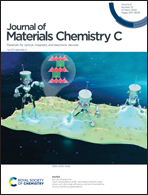H-Bonding on spin centres enhances spin–spin coupling for organic diradicals†
Abstract
Organic magnetic materials must possess sufficient magnetic coupling to realise their potential. Most coupling studies were based on intramolecular modifications because the molecular structure ultimately dictates the molecule's properties. In this study, non-covalent interactions, specifically hydrogen bonding (HB), are explored as a strategy to enhance the magnetic coupling in a diradical. Model systems were conceptualised based on nitroxide (NO) and nitronyl nitroxides (NN) as spin centres (SCs) with an acetylene-bridged phenylene coupler. The combinations and orientations of SCs were chosen so that a ferromagnetic diradical would result, meaning two NOs are meta directionally oriented (mNO-NO) while NO and NN are in para positions (pNN-NO). Hydrogen-bonding was introduced to mNO-NO and pNN-NO using HX as HB donors (HX = HF, HCl, HBr, H2O, and NH3). HB interaction energies were calculated with relative strengths in the following order: HF > HCl > H2O ≈ HBr > NH3. Reduced density gradients (RDG) confirm the presence of HB and the relative strengths of HX varies incrementally. This justifies using them to investigate how the HB interaction energy influences diradical magnetic coupling. Magnetic coupling revealed through J values was found to have a linear dependence on the HB strength. An improved J value is associated with a decrease in total spin density values on major atom sites N and O. This work demonstrates the potential use of HB for further increasing the magnetic exchange in organic magnetic materials. Insights derived from this work can be used in the design of diradical aggregates.



 Please wait while we load your content...
Please wait while we load your content...